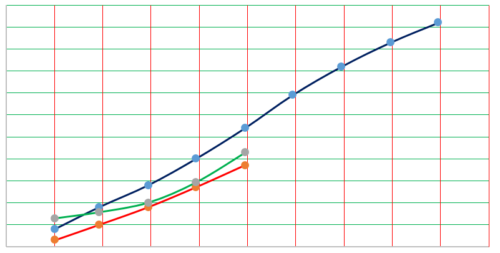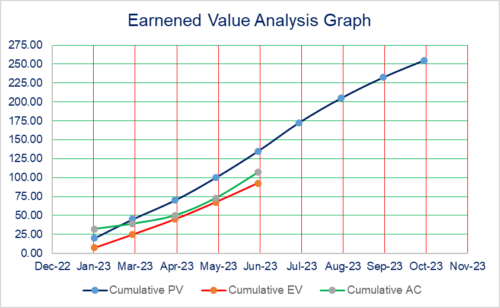
Earned Value Management or EVM can be your most useful tool in tracking the cost and progress of your project. It is, indeed, the most easy tool to track a project, be it a construction project or software or anything. There is not many prerequisites for implementing EVM to a project.
What is Earned Value Management in Project Management?
Earned Value Management in project management is an extremely simple and useful tool to measure the project’s progress and cost performance, and issue early signals for any overrun in cost and schedule. ‘Earned Value’ means how much value you have ‘earned’ in a project. Note that, to ‘earn’ value you have to execute the work in a project, and the budgeted cost of the quantum of work executed in a project is what you have ‘earned’, that you can spend. The actual cost, ideally, should be within this earned value of any project to keep it within the budget.
History of Earned Value Management
Earned Value Management (EVM) was originated in 1960. It was initially developed as a part of the Program Evaluation and Review Technique (PERT) for the US Navy’s Polaris missile program. Formal integration of EVM, its concepts and techniques in project management practices started in the late 1960s and early 1970s. The US Department of Defense (DoD) played a significant role in promoting and refining EVM, as in 1967, the DoD issued Cost/Schedule Control Systems Criteria (C/SCSC), that established the principles of EVM and provided guidelines for its implementation.
Over the years, EVM techniques were further developed and refined and became widely used in project management. EVM’s ability to provide early warning signals of issues about project performance issues and integration of cost, schedule and scope data made EVM an essential tool to manage complex projects. The principles and techniques of EVM have been integrated into the Project Management Institute’s (PMI) guidebook Project Management Body of Knowledge (PMBOK) and also ISO standards of project management.
In this article, you will learn to implement Earned Value Management in any type of projects, step-by-step.
What are the Components of Earned Value Management?
- How much work was planned to be done by a specified point of time?
- How much work has actually been completed by this point in time?
- How much did the work actually cost?
There are three questions that forms the base of Earned Value Management.
From question 1, we get what is the Budgeted cost of the work that we had planned to complete up to a certain point of time. This is called the Planned Value (PV). It is also called the Budgeted Cost of the Work Scheduled or BCWS in short.
From question 2, we get what is the Budgeted cost of the work that actually completed up to that point of time. This is called the Earned Value (EV). It is also called the Budgeted Cost of the Work Performed or BCWP in short.
Remember, this is not the cost of the actual work done, but the ‘Budgeted Cost’ of the ‘work actually done’. That means, we anticipated some cost (based on market price and standard co-efficient of resources) per unit of work, and that anticipated cost per unit multiplied by the quantity of work executed is the EV.
A Simple Example of Earned Value Management
If an activity has a budget of B per unit, and you planned to execute P1 units of it up to a certain time, but end up doing P2 units up to that time, then up to that specific point of time,
Planned Value (PV) = P1 x B
Earned Value (EV) = P2 x B
Example-1: We have planned 1000 cubic meter concreting work in 4 months, with a proportionate 250 cu.m per month plan. Cost per cubic meter of concrete budgeted was Rs. 5000. After end of the first month, we observe that we have done 200 cubic meter concreting in the project. What is the PV and EV?
PV = Planned Value = 250 cubic meter x Rs. 5000 per cu.m = Rs. 12,50,000
EV = Earned Value = 200 cubic meter x Rs. 5000 per cu.m = Rs. 10,00,000
Point to note that, in both PV and EV the rate is same, that is the budgeted rate of the activities. In this case, it is s. 5000 per cubic meter.
From question 3, we get the actual cost of the work that is incurred in practice. Let us consider that the rate of cement has increased and the cost per cubic meter of concrete is also increased for the same reason. If per cubic meter cost increase is Rs. 500, then the actual cost incurred is = Rs. 5000 + Rs. 500 = Rs. 5500 per cubic meter.
And, the AC = Actual cost incurred = 200 cubic meter x Rs. 5500 = Rs. 11,00,000
So, by now we have got all the required inputs for the Earned Value Management (EVM) of this project.
Watch this Video Tutorial on Earned Value Management:
Indexes of Earned Value Management
With the data we have calculated as above, now we can calculate the indexes of the Earned Value Management. The four major indexes in EVM are:
- Cost Performance Index
- Schedule Performance Index
- Cost Variance
- Schedule Variance
Now, let us see one by one what are the above indexes in detail, and understand the Earned Value Management formulas with an easy example.
Cost Performance Index (CPI) in EVM
The formula for CPI is, CPI = EV / AC = (Earned Value / Actual Cost)
In the example given above, EV = Rs. 10,00,000 and AC = Rs. 11,00,000
So, CPI = EV / AC = 1000000 / 1100000 = 0.91
If the CPI is less than 1 then we can interpret that the project is over-budget. This means, the cost incurred is more than anticipated cost of the project. If the CPI is more than 1, we can say that the project is within the budget. CPI value of 1 implies that the project is exactly on-budget (not a practical scenario for a large, complex project).
Schedule Performance Index (SPI) in EVM
The formula for SPI is, SPI = EV / PV = (Earned Value / Planned Value)
In the example given above, EV = Rs. 10,00,000 and PV = Rs. 12,50,000
So, SPI = EV / PV = 1000000 / 1250000 = 0.80
If the SPI is less than 1 then we can interpret that the project is behind the schedule. This implies a delay in the project. If the SPI is more than 1, we can say that the project is ahead of the schedule. SPI value of 1 implies that the project is exactly on-schedule (not a practical scenario for a large, complex project).
Cost Variance (CV) in EVM
Cost Variance of a project is simple, it is CV = EV – AC
In our example-1, CV = 10 – 11 = -1 Lakhs INR.
Significance of this is, the project is INR 1 lakhs over budget for the till date executed work. A negative value of CV means the project being over-budget and positive value of SV means the project is within the budget. The value of the CV is the magnitude of the excess or savings with respect to the budget.
Schedule Variance (SV)
Schedule Variance of a project is, SV = EV – PV
In our example-1, SV = 10 – 12.5 = -2.5 Lakhs INR.
A negative SV implies a project behind the schedule while a positive SV means the project is ahead of the schedule.
A Bigger Example of EVM
Example-2: Following is the schedule and budgeted cost of concreting in a project where the duration is 9 months. We consider the budgeted rate of concreting Rs. 5000 per cubic meter.

By multiplying the rows A and B we get the PV of each month.

Now, this is a 9 months’ project, and let us consider the progress of the work as below after 5 months from beginning.

From this, now we can find out the actual cost of the project month-wise. Multiply rows D with B and get the EV (Earned Value). Also, track the actual cost month wise to get the ratios.

Now, we need to calculate the month-wise cumulative values of the PV, EV, and AC and get the trend of the CPI and SPI from the table very easily.

From the above table we get this graph in Excel.

From the graph we see that the PV line (blue) is above the EV line (red). This implements that the project is well behind the schedule.
Also, we find that the EV line is even below the AC line (green). It implements that the project is over-budget.
You can download the excel file from the link below:
How to Implement Earned Value Management to Your Project?
All you need are three things to implement Earned Value Management (EVM) to your project.
One, a schedule in detail from which you can tell where the project should be at any specified point of time. You need to determine the Work Breakdown Structure or WBS is enough details so that the same reflects the plan of the project well.
Two, a budget in detail from which you can tell what cost it should have incurred after completing the work at that specified point of time. You need to assign the planned cost to all the WBS you have created in step-1.
Three, You must keep handy the cost statement of your project at that specified point of time.
With these three steps you are now ready to implement Earned Value Management to your project.
Earned Value Management for Projects with Multiple Activities
The more practical scenario is a project with more than one activity. The projects we work in are more of this type as we encounter multiple activities in them. Earned Value Analysis of all the individual items will enable you to understand which particular item is creating the issue in the delay and cost overrun.
Example-3: Let us consider such a project with 3 activities (you can add n numbers of activities with the same procedure). We have considered duration of the project as 5 months only to keep it simple to understand. You can consider whatever duration you want. The procedure is same. Here we have considered 3 activities – Concreting, Blockwork, and Structural steel work.
Step-1: we prepared the schedule of the project (3 activities). Then we have distributed the quantities of the activities as per the scope and get this below table.

Step-2: Let’s decide the budget of each activity. Put the budgeted cost of each activity.

Step-3: Distribution of scope quantities of each activity

Step-4: We get the Planned Value of each item from the above.

Step-5: Get the actual quantities of each activity you have executed till a certain period. Here we are considering up to March 2023.

Step-6: Now calculate the Earned Value (EV), and calculate CPI and SPI after noting down the Actual Cost from the cost statement of your project.

Download the excel file from the link below:
If you have any query you may ask it in the comment section. Let’s implement Earned Value Management in your project and let us know how it is going on. Happy managing!
